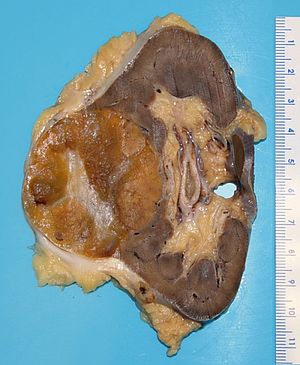Gross pathology
Jump to navigation
Jump to search

Gross pathology, also simply gross, refers to the macroscopic pathology, and the macroscopic assessment of pathology specimens. It may include preparation of tissue for a microscopic examination. It is an essential part of pathologic assessments.

A kidney tumour (renal oncocytoma) at the time of grossing.
The process of cutting up specimens is known as grossing (North American term), cut-up or macroscopic cut-up (Australian term).
Specimen opening
- Usually referred to simply as opening.
- May go by the term freshing.
- The first part of a gross pathologic assessment.
Components
- Orient the specimen.
- Paint with ink - if applicable.
- A good general rule is: ink before you think.
- Cut open for fixation - if not immediately blocked.
- +/-Weigh.
- +/-Insert paper towels in the cuts (book marking) for fixation.
Gross only
Gross only specimens are examined only at the grossing bench; no microscopy is done. Which specimens are considered "gross only" typically depends on institutional policy.[1]
Principles of grossing
Main article: Principles of grossing
This article is discusses generalities in grossing.
Common gross only specimens
- Teeth.
- Foreign bodies.
- Femoral head with osteoarthritis - no fracture & no history of cancer.
- Calcific aortic stenosis.
Gross pathology spot diagnoses
Main article: Gross pathology spot diagnoses
This is a long list of things that can be identified with a reasonable certainty on gross.
See also
- Basics.
- EIT.
- Tissue loss.
References
- ↑ Zarbo, RJ.; Nakhleh, RE. (Feb 1999). "Surgical pathology specimens for gross examination only and exempt from submission: a College of American Pathologists Q-Probes study of current policies in 413 institutions.". Arch Pathol Lab Med 123 (2): 133-9. doi:10.1043/0003-9985(1999)1230133:SPSFGE2.0.CO;2. PMID 10050786.